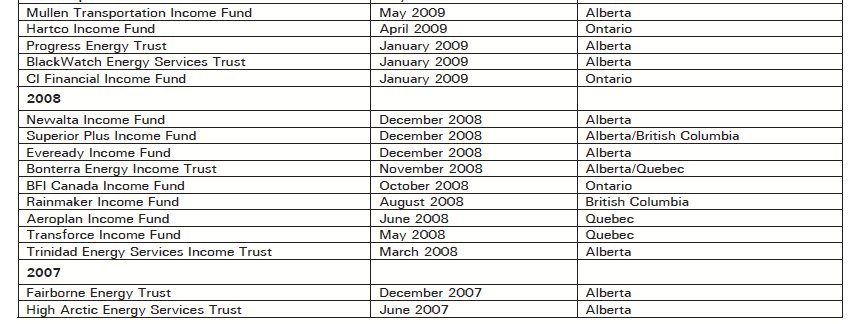Copyright 2010, Blake, Cassels & Graydon LLP
Originally published in Blakes Bulletin on Income Trusts, March 2010
Canadian income trusts will become subject to taxation beginning on January 1, 2011, under Canadian income tax rules announced in 2006 that apply to "specified investment flow-through" entities, or "SIFTs". The SIFT taxation rules will impose a tax on income trusts and other SIFTs that is equivalent to the corporate tax rate, and treat distributions to unitholders in a manner comparable to dividends paid by a corporation to shareholders. This will effectively remove the flowthrough tax advantages previously enjoyed by SIFTs relative to taxable Canadian corporations.
Since the SIFT tax changes were announced, more than 50 income trusts have been acquired or privatized, and almost as many have chosen to convert to a corporate structure (see the summary below). As 2011 quickly approaches, we expect many of the remaining income trusts in Canada to convert to corporate form in 2010 prior to the tax changes becoming applicable.
This Blakes Bulletin discusses some of the principal issues relevant to the consideration of the conversion of an income trust to a corporate structure, and provides an update on conversion activity to date.
Background
On October 31, 2006, the Canadian Minister of Finance announced the Canadian federal government's plans to change the tax treatment of income trusts. Under these plans, the government will apply a tax at the trust level on distributions of certain income from, among other entities, most publicly traded income trusts and partnerships in Canada (referred to as SIFTs) at a rate of tax comparable to the combined federal and provincial corporate tax rate and treat such distributions as dividends to unitholders. Amendments to the Income Tax Act (Canada) to implement these tax changes were enacted in 2007 and will apply to income trusts beginning in the 2011 taxation year (or earlier if an income trust exceeds certain "normal growth" limitations set out in the amended legislation).
In July 2008, the Minister released further proposed amendments to the Income Tax Act (Canada) to facilitate the conversion of an income trust to a corporation without unduly negative tax consequences for the trust or its unitholders. With some additional refinements, these proposals were enacted into law in March 2009. Please refer to our July 2008 Blakes Bulletin on Income Trusts: SIFT Conversion Rules Announced (http://www.blakes.com/english/legal_updates/tax/july_2008/Income_trust_July2008.pdf) and our December 2008 Blakes Bulletin on Tax: Minister of Finance Announces Changes to SIFT Conversion Rules and Normal Growth Guidelines (http://www.blakes.com/english/legal_updates/tax/december_2008/SIFTs_Update.pdf) for a discussion of these rules and the methods of conversion that they contemplate.
The proposed tax changes initially resulted in a great deal of M&A activity involving income trusts. They also led to a handful of income trusts converting to corporate form in 2007 and the early part of 2008. In the second half of 2008 and in 2009, particularly after the SIFT conversion rules were published, the pace of income trust conversions accelerated. At the end of this bulletin, there is a list of selected income trust conversions to corporate form that have been completed and announced to date.
Alternatives
As the imposition of SIFT taxation approaches, income trusts have three main choices available to them:
1. Remain an Income Trust
Some income trusts may choose to simply remain as income trusts after January 1, 2011. They may have available tax losses to apply against income that would otherwise be taxable, or they may determine that they do not wish to incur the cost of a conversion transaction. It should be recognized, however, that the SIFT conversion rules that facilitate conversion to a corporate structure without undue tax consequences currently apply only to conversions completed by December 2012.
2. Convert to a Corporate Structure
We expect many income trusts will determine to convert to a corporate structure. Some of the benefits cited by income trusts that have already converted include greater flexibility in the use of cash flow, simplicity of structure, greater comparability to corporate peers and better access to capital for corporations.
3. Merger or Sale
A merger or sale of the income trust or its business may be a feasible alternative, if an attractive transaction arises.
Until recently, some income trusts had been able to convert to corporate form by effectively combining their businesses with a previously existing, unrelated corporation with accumulated tax losses, with a view to utilizing the accumulated tax losses as deductions against future income. In its budget announcement on March 4, 2010, the federal government announced measures that will effectively prevent these "lossco" conversions in future. Please refer to our March 2010 Blakes Bulletin on Tax: 201 0 Federal Budget (http://www.blakes.com/english/legal_updates/tax/mar_2010/Budget2010.pdf) for more information.
The discussion below relates to some of the principal issues to consider when an income trust has chosen to convert to a corporate structure.
Unit holder Approvals
It is likely that a conversion of an income trust to a corporate structure will require approval by a special resolution of unitholders of the trust at a meeting of unitholders under the terms of the income trust's Declaration of Trust. Typically, a special resolution is required to be approved by at least two-thirds of the votes cast by unitholders at the meeting. If the income trust has both trust units and "special voting units" outstanding, they will typically vote together in approving the special resolution.
If the income trust's capital structure includes exchangeable securities of a subsidiary corporation or partnership, as is often the case, it is possible that additional approvals by the holders of these interests may be required. The terms of the relevant agreements governing these types of exchangeable interests should be reviewed in this regard.
If the conversion transaction results in a related party of the income trust receiving different consideration than the public unitholders, or some other collateral benefit, or otherwise engaging in a related party transaction with the trust or its public company successor, the minority security holder protections of Multilateral Instrument 61-101 – Protection of Minority Security Holders in Special Transactions, may apply. If applicable, this could require that the income trust obtain a formal valuation of its trust units and minority approval of the transaction (that is, approval by a 'majority of the minority' of disinterested unitholders, excluding the votes of the applicable related party). This could happen if, for example, a related party (such as a 10% unitholder of the income trust) sells assets to the trust or the new public corporation, purchases assets from the trust or the new public corporation, or receives shares of a different class than those received by public unitholders on the conversion.
Plan of Arrangement
In order to complete the steps of a conversion transaction in the required sequence, and to permit the delivery of shares of the successor public corporation to trust unitholders in the United States in reliance upon available exemptions from registration under U.S. securities laws, a trust conversion will almost always proceed by way of a plan of arrangement under the Canada Business Corporations Act (the CBCA) or an equivalent provincial corporations statute. This process usually involves:
- an application to the court in the income trust's principal jurisdiction for an interim order of the court relating to the procedure of calling and holding the unitholder meeting, sending meeting materials and voting at the meeting;
- approval of the transaction by unitholders in the manner required by law and the interim order; and
- following approval by unitholders at the meeting, an application to the court for a final order approving the plan of arrangement. In considering whether to grant the final order, the court will review the transaction on the basis of the procedural and substantive fairness of the transaction to the trust's unitholders and other affected parties, if any.
Although a plan of arrangement is a procedure that is provided for under corporate law, Canadian courts have accepted that the procedure is available for the conversion of an income trust into a corporate structure so long as there is at least one corporate applicant involved with the transaction. Typically, the new public corporation and one or more corporations within the income trust's group of subsidiaries will be able to act in this capacity.
Often, the Declaration of Trust for an income trust does not provide unitholders with the right to dissent from an arrangement or similar transaction and claim fair value for their units. As such, trust unitholders will often not be entitled to dissent rights. In many conversions, but by no means all, the income trust has chosen to grant unitholders a right of dissent similar to that provided under section 190 of the CBCA and similar provisions of provincial corporate law.
Governance and Board Approval
In considering a conversion transaction or other alternatives, the trustees/directors of an income trust must act with regard to their duties under the trust's Declaration of Trust or other governing instrument. As such, they must determine that the proposed course of action is in the best interests of the income trust's unitholders.
Among the factors that may be relevant to the consideration of a conversion transaction are:
- the impact of the new tax regime on the income trust and its ability to pay distributions to unitholders;
- the needs of the enterprise to raise capital and the ability (or lack thereof) and cost of doing so as an income trust versus a corporation;
- the possible broadening of the enterprise's potential investor base since, in most cases, a corporation would not be subject to the foreign ownership limitations that apply to income trusts;
- the ability to provide taxable Canadian unitholders with a tax-free "rollover" on their acquisition of shares of the new public corporation, under the SIFT conversion rules, which will not be available after 2012;
- comparability with other similar businesses that may exist in, or have converted to, corporate form; and
- the advice and conclusions of any financial advisor that may have been retained by the trustees, as to the fairness of the conversion transaction to unitholders.
If there are concerns that a trustee, director, officer or other related party of the income trust may receive different consideration or otherwise have interests that differ from those of the income trust or other unitholders, or other conflicts of interest exist, it may be appropriate for the trustees or directors, as applicable, to form a special committee of independent trustees or directors to consider the transaction and make a recommendation to the full board.
As noted above, a financial advisor may be engaged to advise the trustees/directors with respect to the conversion to a corporation. The role of a financial advisor in this context is to assist the trustees/directors in their due diligence of the conversion transaction and, in particular, to provide advice as to whether the consideration offered in the conversion transaction is fair from a financial point of view to the unitholders of the income trust. While there is generally no legal requirement for a fairness opinion in respect of a conversion transaction and the approach on conversion transactions already completed has varied, it has not been uncommon to retain a financial advisor for this purpose even for relatively straightforward conversion transactions, and in particular where the decision has been taken to convert prior to January 1, 2011 or where the transaction is more than simply a continuity of the existing business within a new corporate entity by the inclusion of other changes to the business or capital structure of the resulting corporation.
Compensation and Incentive Plans
Many income trusts have, concurrent with converting to a corporate structure, sought unitholder approval for new compensation and incentive plans. In certain cases this may result from the transition of the entity from a distribution-paying income trust to a growth-oriented corporation, with the effect that the design objectives in existing compensation and incentive plans would not be appropriate for the new corporate issuer. In other cases this may also reflect the income trust taking the opportunity afforded by the conversion transaction to generally update its compensation and incentive structures to reflect current market practices.
It is important for issuers to first identify the effect of the planned conversion structure on existing compensation and incentive arrangements in order to identify issues such as accelerated vesting and perceived shortcomings in the design of an existing plan relative to the strategic objectives of the resulting corporate issuer. Compensation committees also need to carefully examine these matters and, if necessary, seek advice regarding plan design in order to provide the board with an informed view regarding modifications to existing compensation and incentive plans or the adoption of new plans.
Convertible Debentures
Many income trusts have issued convertible debentures. These debentures are debt instruments that are convertible by the holders into units of the income trust at a fixed conversion price. Typically, the terms of convertible debentures will include an adjustment clause that will adjust the conversion entitlement in the event of a plan of arrangement or other transaction affecting the trust units, so that debentureholders who exercise their conversion rights after completion of a corporate conversion will be entitled to receive shares of the new public corporation, rather than units of the predecessor income trust.
A conversion transaction should be structured in a manner that triggers the applicable adjustment clause and allows the new public corporation to become the successor obligor to the income trust. Many convertible debentures feature a right for the debentureholders to require the issuer to repurchase their debentures at a slight premium to face value if there is a "change of control". In most cases, income trusts have been able to structure conversion transactions so that any change of control put rights are not triggered as a result of the conversion.
Other Exchangeable Securities
In many income trusts, an equity ownership stake was retained by the initial vendor(s) or former shareholder(s) of the income trust's underlying business. This is sometimes referred to as a "retained interest". A retained interest in an income trust is typically held in the form of units of a subsidiary limited partnership, or shares of a subsidiary corporation, that are exchangeable for units of the publicly traded income trust at the option of the retained interest holder.
In most income trust conversions to date where there was a retained interest, the retained interest has also been exchanged for shares of the new public company. If nothing else, this has the benefit of simplifying the corporate structure by having all equity security holders become shareholders of the new public corporation, rather than having them split between the income trust and a subsidiary entity.
It may also be possible to leave the retained interest in place, if the terms applicable to it will adjust the exchange entitlement so that the holder will receive, upon exchange, shares of the new public company rather than units of the (now privatized) income trust. This has been done in at least one conversion, that of BFI Canada Income Fund.
Other Considerations
Other considerations may apply to a particular conversion transaction, including the following:
- If the resulting corporate issuer was a subsidiary of the income trust prior to conversion, it may be necessary to amend and/or update the by-laws of that company to align with governance requirements, changes to permitted director residency requirements, electronic participation in shareholder meetings and the use of a direct share registration system;
- Appropriate due diligence should be planned in respect of key contracts, permits and authorizations to ensure any change of control or assignment provisions that may be triggered by the conversion are identified sufficiently in advance of the conversion to allow necessary consents to be obtained or structuring alternatives identified; and
- The information circular provided to unitholders in connection with a proposed conversion may need to contain certain financial statements and pro forma financial statements of the resulting corporate entity. In certain cases, it may be possible, and preferable, to obtain exemptive relief from these financial statement requirements from the applicable Canadian securities regulatory authorities.
Timing of Conversion
The trust's management and board will need to decide on the timing of conversion – essentially, whether to convert at some time during 2010, before the new tax regime becomes applicable, or to wait until the very end of 2010 or early 2011, to take full advantage of the trust's flow-through status before the new tax takes effect. For some trusts, factors such as the certainty of having completed the conversion or the removal of the "normal growth" limitations may weigh in favour of converting early. Others may determine that it would be better to convert at the end of 2010 or early in 2011, to take advantage of the existing tax regime through to the end of 2010.


The content of this article is intended to provide a general guide to the subject matter. Specialist advice should be sought about your specific circumstances.



